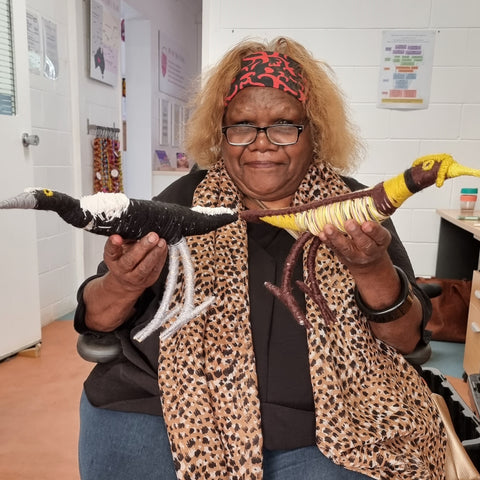Celebrating life, creativity, and country.
About Us
Tjanpi Desert Weavers is a social enterprise of the Ngaanyatjarra Pitjantjatjara Yankunytjatjara (NPY) Women’s Council, working with women in the remote Central and Western desert regions who earn an income from contemporary fibre art. Tjanpi (meaning grass in Pitjantjatjara language) represents over 400 Anangu/Yarnangu women artists from 26 remote communities on the NPY lands.
The NPY lands cover approximately 350,000 square kilometres across the tri-state (WA, SA, NT) border region of Central Australia (please see the map below) and Tjanpi field officers regularly traverse this area to visit each community. On these trips, field officers purchase artworks from artists, supply art materials, hold skills development workshops, and facilitate grass-collecting. While out collecting grass, women are also able to spend time on Country and maintain their culture through gathering food, hunting, performing inma (cultural song and dance), and teaching their children.

Tjanpi artists use native grasses to make spectacular contemporary fibre art, weaving beautiful baskets and sculptures and displaying endless creativity and inventiveness. Originally developing from the traditional practice of making manguri rings, working with fibre in this way has become a fundamental part of Central and Western desert culture.
Tjanpi embodies the energies and rhythms of Country, culture and community. The shared stories, skills and experiences of this wide-reaching network of mothers, daughters, aunties, sisters and grandmothers form the bloodline of the desert weaving phenomenon and have fuelled Tjanpi’s rich history of collaborative practice.
Tjanpi has a public gallery in Alice Springs showcasing baskets, sculptures, jewellery, books, merchandise and more, while Tjanpi artworks are also found at stockists around the country. Tjanpi regularly exhibits work in national galleries and facilitates commissions for public institutions.
“It’s good for young women too. We can show them the sacred sites, special grass and best time to go and get them. We can tell stories while we’re collecting the grass and making the baskets.” Kanytjupayi Benson, Papulankutja WA

